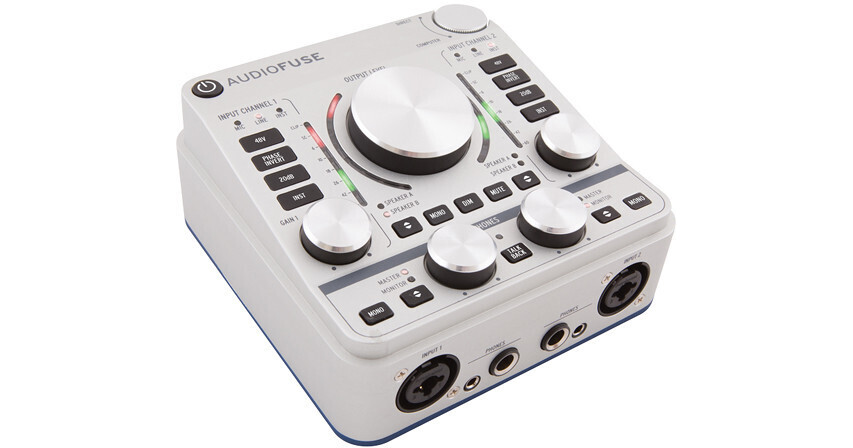Arturia Audiofuse Usb-interface For Mac
- Arturia Audiofuse Usb-interface For Mac Os
- Arturia Audio Fuse Usb-interface For Mac Os
- Arturia Audio Fuse Usb-interface For Mac Free
Arturia AudioFuse A great all-rounder, but the compact size, multi-connections, USB hub and standalone capabilities make this a beast for mobile performance and recording. Pros: – Connectivity options – Hands-on controls – Easy reamping Cons: – A bit pricey – Poor talkback mic Arturia is one of our favourite audio companies at the moment, in terms of the creativity and edge that they bring to their tech, that stands them out. They are purveyors of excellent hardware in the shape of their synths and controllers. They have stepped up their software game massively with huge leaps and bounds forward in the quality and stability of their. Now, after what seems like an eternity of announcements, the AudioFuse has been released into the wild, and has been making waves for the last few months. Here’s yours truly and his little partner-in-crime welcoming the arrival of the AudioFuse AudioFuse, Arturia’s first step into the audio interface market, is a solid and compact aluminum chassis.
A lot of attention has been paid to the design. I feel like they’ve gone the opposite route to the more minimalist offerings presently available, and have worked hard to pack as much hands-on control as possible, without clutter. A similar principle has been applied to the connectivity. How much can fit onto that little box??
Connected 14 channel I/O consisting of 2 custom built DiscretePro preamps with +48v pad, 4 line/instrument ins, stereo phono ins, SPDIF, ADAT in and out, 2 stereo speaker outs, midi breakout (DON’T LOSE THE CABLES!!!!!), 2 TRS inserts for adding your favourite outboard AudioFuse is Bus powered via USB2, or can be DC powered (wart included). More on the power in a bit. AudioFuse is class compliant, and works with Mac, Windows, Linux, but also iOS out of the box!
Additionally, Arturia found room to squeeze in a 3-port USB2 hub to add additional equipment, and two independent headphone outs (via both connection sizes, so you never have to look for that stupid adapter thing again!!) Audio Specs “But what about the specs?” I hear you ask. Well, they’re good. Very good, actually. Arturia sends out a certificate with each machine, showing their precise specs: It’s a nice touch that shows all the info, while assuring you that the product has been properly tested. As you can see, Arturia have tried to create a sound card that gives as little distortion as possible, as little noise as possible, and as flat a response as possible. And haven’t they done well!!
One of the reasons the AudioFuse took so long was because they went back to the drawing board with the technology, and updated it all. And it paid off; The sound I got from the little box was clean, clear, defined, all the descriptors you’d be looking for from a sound card. I was similarly impressed with the preamps on instruments and vocals – flat response, clean and clear. I could add my own color after if I wanted.
The latency was fine on my Mac Trashcan. As it’s class compliant, it runs off the core audio, so gives the standard latency specs from that driver. Nothing that I noticed as an issue. I read that it’s similarly good for Windows and Linux too. AudioFuse Control Center When you register your AudioFuse, you get firmware and software downloads to bring the sound card up to date, and also to install the mixer software, entitled AudioFuse Control Center. It duplicates most of the hardware controls, but also contains a few more extra elements useful to the overall experience, perhaps the main one being at the bottom of the screen – the direct monitor mix. There you can control what is coming from where, how much, and then you can control where you send it to, from the three output mixes – main, cue 1 and cue 2.

This gives you a myriad of possibilities for directing your sound. You can set up the AudioFuse mix in the software, then save it and use the AudioFuse standalone if you want, as a direct mix box for performance for example. You can also adjust sample rate, clock source, digital I/O directions (SPDIF in, ADAT out, for example), and a few other things that I’ll mention later on.

Overall, the software is fairly intuitive, simple setup. I didn’t find myself going to it that often, as there was so much built into the hardware I didn’t need to. Cool Touches So as a sound card, AudioFuse ticks all the boxes; It sounds great and it’s solid and stable in operation. So what would make me take a second look at it, over the myriad of competitors offering excellent hardware?
Well, I think Arturia have definitely spent some time thinking about how to be creative with this box, and add elements that make it a bit indispensable for the performing/recording musician. Here’s a list of extra elements that I thought were really useful/cool/thoughtful: – Hands-on design choice. I think Arturia succeeded in making ALL the main controls of AudioFuse fit right on to the top of the box. Preamp gains, output levels, headphone mixes, talkback, speaker outs, mono/stereo switch; it’s all right there, NO menu diving. – Re-amping option. In the software, you can re-direct speaker B out as a re-amp box, altering the impedance accordingly. This is something I definitely wish I had on my sound card, so I had more options when it came to re-recording guitar, or playing synths through guitar effects for example.
There are workarounds for all that, but this makes it so simple!! – MONO buttons. They’re on the main mix, and on the headphone outs. I find myself heading to MONO more and more nowadays as a great mix and phase check. Having it right there at your fingertips – Headphone outs. 2 size outs for 2(!) independent headphone cues. Just thoughtful.
Arturia Audiofuse Usb-interface For Mac Os
– Button for software open/close. Does what it says on the tin. Push the button and the software appears.
– Powermodes. In the pref section in the software, you can choose the power mode you want to operate in, from full power to a ‘green mixdown’mode that shuts off all the inputs, thus requiring much less power, and therefore extra battery time if you’re on the road/in the park while you’re creating. Such a useful idea! – Total Protection – This might sound weird but the solid aluminum lid means total protection if you’re on the road, or shoving it in your backpack. When you get it out, you can stick the lid on the bottom of the sound card to give it that extra bit of height if needed. The talkback mic is terrible. You’d be more clearly heard by shouting!
Conclusion I think Arturia have done really well with AudioFuse. It’s a great all-rounder, but the compact size, multi-connections, USB hub and standalone capabilities make this a beast for mobile performance and recording, and I feel that this is where it will stand out. Bravo for the obvious deep thought that went into providing some essential extras on top of a really solid sonic foundation (aside from the talkback mic, see above). For the price, its competitors are going to be the RME babyface, the Focusrite Clarett range, and UAD Apollo twin/arrow, and it can hold its head up amongst esteemed associates. AudioFuse comes in 3 different colour styles, and costs $599.
Arturia Audio Fuse Usb-interface For Mac Os
For more info see. You can also.
Arturia Audio Fuse Usb-interface For Mac Free
If you click the link and buy something, we will earn a small commission. We do this linking rarely, and any fees we make support the costs of this site.
